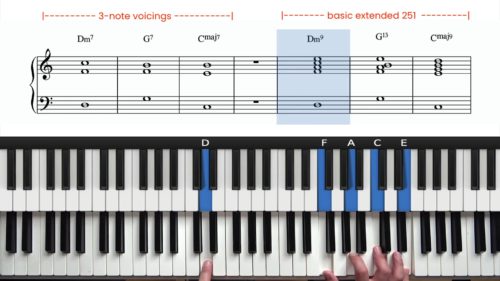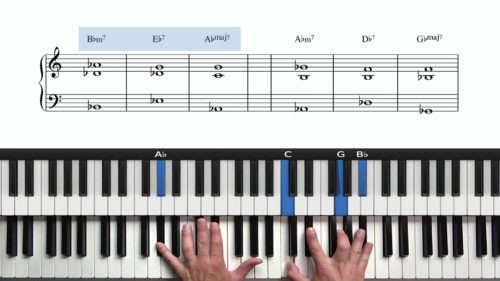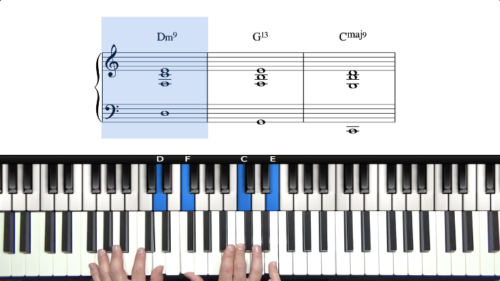Simplified Foundations Practice Guide
We have 2 practice planners for our jazz piano foundations course.
This is the simplified practice guide which focuses on the most important theory needed to progress. These theory areas are:
- Learning the 12 major scales numerically (1-2-3-4-5-6-7)
- Forming a basic understanding diatonic 7th chords in major keys
- Using this information to construct and recognise the 12 major 251s
The objective of this simplified practice planner is to equip you with the essential knowledge needed to progress onto the subsequent courses on Chord Extensions, Rootless Voicings, & Altered Harmony.
Advanced Foundations Practice Guide
The second practice planner in this course is more advanced and the exercises and drill variations covered in that planner can be studied over many months or even many years.
A Key Based Approach To Practice
In this practice routine we will go through all of the drills in the same key, and then move onto the next key. You will find a PDF practice planner in the downloads section of the page which outlines the 6 drills and also contains a circle of fifths diagram showing the major keys and their corresponding key signatures.
The 6 Essential Drills
- Drill 1 – Play the major scale over 2 octaves
- Drill 2 – Flatten the 3rd & 7th to play the Dorian mode over 2 octaves
- Drill 3 – Play the major triad inversions over 2 octaves
- Drill 4 – Play the minor triad inversions over 2 octaves
- Drill 5 – Play the diatonic 7th chords of major scale (M/m/m/M/D/m/m7b5)
- Drill 6 – Play the 3-note 251 progression in type A and type B
Lesson Downloads
-
Foundations Practice Guide (simplified) File Type: pdf
-
Major Scale Fingerings PDF File Type: pdf
-
Major Scale Diatonic 7th Chords File Type: pdf
-
3-Note 251 Progressions PDF File Type: pdf
-
Whole Step 3-Note 251s – Type A File Type: pdf
Practice Tips
-
Start in C Major and move counter clockwise around the circle.
-
Each time you complete the 6 drills for a specific key, add a tally mark next to that key on the circle.
-
This helps us to keep track of our progress and ensure that we building a strong and even foundations by practicing all keys equally.






Hello @Hayden
These drills are great for a beginner – thank you. On following the above session my question on drills 3 and 4 would be: do I do the triads in both hands or just the right as you did in the video?
Thanks Donna
Hi Donna 👋
Great question.
My suggestion would be to just focus on the right hand triad inversions and arpeggios.
When playing upper structure triads, for example, the triad is always voiced in the right hand and so being able to both clearly visualise and comfortably manoeuvre/invert the triad shapes in the right hand is essential. The same applies when arpeggiating a triad up the keyboard, it’s usually played with the right hand.
For left hand work I would recommend focusing on rootless left hand voicings which we study in the course on “Mastering Left Hand Voicings”. When playing jazz piano, it’s far more common to play 3 or 4 note rootless structures in the left hand than it is to play triad shapes.
Check out the 6 practice-focused lessons in our rootless voicings course for more information: https://www.pianogroove.com/jazz-piano-lessons/left-hand-voicings/
I hope that helps Donna and let me know if you have any other questions :–)
Cheers, Hayden
Thank you Hayden – that’s great. Also good to have something for my left hand which is obviously weaker!
Cheers Donna
Hi Hayden,
Beginner here…can you explain better this “Learning the 12 major scales numerically (1-2-3-4-5-6-7)”? I’m used to memorize the notes (Do, Re,…), so what do you recommend? Thanks!
Hi Alex,
In jazz music it is best to think in terms of numbers. With any chord voicing, I think in terms of numbers, ie. the “So What Chord” is built from the tones 1 and 4 in the left hand, and 7, 3, and 5 in the right hand. Check out the lesson here – https://www.pianogroove.com/jazz-piano-lessons/so-what-chord-voicing/ – and also check out the other chord voicing lessons in the chord extensions course: https://www.pianogroove.com/jazz-piano-lessons/extended-chords-voicings/ – this will help you to see why thinking in terms of numbers is important.
I didn’t learn music using the Fixed Do System, and so it is difficult to comment. I know that in jazz education we do not learn in terms of Do, Re.. etc… – and so check out the lessons above and you will see why using numbers is more efficient and effective.
Cheers, Hayden
When I’m playing Dorian mode, is it OK to think of it as the second degree of another major scale. In other words if I’m playing E-flat Dorian, I can see that it is the same notes as D-flat major. It seems that’s easier for me to think about fingering. Or should I be thinking about in terms of flattening the third and flattening the seventh?
Hi Chad,
Yes that is totally fine. There are essentially 2 ways of learning modes, “the parent scale approach” which is what you are referring to, and the “functional approach” where we analyse the characteristic tones of the mode. I recommend students to follow whichever method is more logical for them. It helps to have an appreciation of both viewpoints, but ultimately it’s 2 ways of looking at the same thing. I hope that helps and let me know if you have any other questions.
Cheers, Hayden
Just a quick comment, first I love Everything thus far. I’ve been playing a little but started from the very start, never can brush up enough no practice enough.
I did notice a error tho, at “TC” 13:52 in on the Ab diatonic drill you called the Ab major a minor chord. It’s Major chord progression we know the “Tonic” is major and the Bb is a dom7 etc. its a easy fix just replace the “vo”. I’ve been in the television production field out here in LA for 36yrs+ thats why i used “TC” timecode, “VO” voice over etc.
I’ve learned so much just don’t want you look bad, There’s so much material on here it’s easy to over look a thing here and there. Love the site
Hi Charles,
Thanks for letting me know about the VO mistake – I will correct this.
I shared some tips in this post on how to approach the lessons for new students: https://community.pianogroove.com/t/which-song-next/8459/3
Also I will be hosting a seminar tomorrow at 12 noon EST where we explore “Listening and Transcription” and how to incorporate this into your practice time. You can add to your calendar here: https://www.pianogroove.com/live-seminars/how-to-transcribe/
I also hosted a seminar in December where we discuss practice related tips and I mentioned the drills in this lesson, you can find the recording of that seminar here in case you missed it: https://www.pianogroove.com/live-seminars/how-what-to-practice/
Hope to see you in the seminar tomorrow!
Cheers, Hayden
Great! Let me check it out. Thanks for the very quick reply
Hi Hayden when are you having another live seminar for beginners? Sam
Hi Sam 👋
Thanks for getting in touch.
I am hosting a beginner jazz theory seminar on the 19th April.
This is a special edition for “Jazz Appreciation Month” and it is hosted on YouTube.
You can see more here: https://www.pianogroove.com/jazz-appreciation-month-2023/#lp-pom-block-13
Click “Register” to save your spot at the events.
Cheers. Hayden
Hi Hayden,
I may have missed out, but what is important to learn the Dorian mode?
Hi Jimmy 👋
Great question!
Without getting into too much theory, the Dorian Mode is simply a variation of the minor scale. The Dorian mode works very nicely over its minor chord, for example C Dorian mode played over C-7. This creates a very free-flowing scale that is suited to melodic development and improvisation.
There are 3 types of minor scale: the natural minor scale, the harmonic minor scale, and the melodic minor scale
and then in jazz we also have a concept called “modes” which are similar to scales, but at the same time subtly different, here is a lesson on modes: https://www.pianogroove.com/jazz-piano-lessons/modes-major-scale-tutorial/ – if you would like to learn about them.
Don’t worry about learning all of these Modes right now, instead focus on this essentials practice guide, and also moving onto the course on chord extensions which you can find here: https://www.pianogroove.com/jazz-piano-lessons/extended-chords-voicings/ – this is where we start to create beautiful jazzy chord voicings using the scales that we learn in the foundations course.
I’d also recommend to watch my course on “Minor Harmony & Improvisation” where we explore minor scales and their use in jazz piano, you can find that course here: https://www.pianogroove.com/jazz-piano-lessons/minor-harmony-improvisation/
That will give you a more functional understanding of minor scales.
As a final tip, understand that scales are not a ‘magic bullet’ to learning improvisation. I’d recommend to watch my course on “Cocktail Piano Improvisation” where we explore the most important building blocks for improvisation:
https://www.pianogroove.com/jazz-piano-lessons/cocktail-improvisation-for-beginners/
Please let me know if I can help further.
Talk soon, Hayden
Hello, Hayden. I have just started “the simplified Practice Planner” and I would like to know if there is a pdf file on the site about the scales in Dorian mode. This would allow me to check if the scales in Dorian mode that I play are correct. Thank you.
Hi Marc,
Yes we do have all of the modes available for PDF download on this page:
https://www.pianogroove.com/jazz-piano-lessons/modes-major-scale-tutorial/
Please see the 2nd download “Major Modes in All 12 Keys”.
Another useful relationship to understand is that the Dorian Mode is the exact same notes as the major scale built from a whole step below.
For example, D Dorian Mode, is the C Major scale played from D to D.
The F Dorian Mode is the Eb Major scale played from F to F. etc…
This is getting more into modal theory, and for myself I just like to think “major scale with the b3 and b7” will give me the Dorian Mode.
Both approaches work so you can choose whichever method you prefer.
Please let me know if I can help further.
Talk soon, Hayden
Hi Hayden,
It seems that the fingering you use in your videos is not the same as the chart of fingerings provided. How important is it for me to learn these exact fingerings?
Sherry
Hey Sherry,
I’m unsure what exercise you are referring to in this lesson, but yes I find is that my fingering is a lot more flexible when playing jazz and blues piano, compared to when I was learning classical piano in my youth, for example.
It’s difficult to provide a set fingering that works for everyone as we all have different sized hands. What I use for a specific chord voicing might not be comfortable or even possible for a student with small hands.
I feel that the most important thing is to find a fingering that works well for you, by all means try the fingerings that I use in the lesson, but understand that fingering is never ‘set in stone’.
Some jazz musicians – Thelonious Monk as a good example – had very novel and unorthodox ways to finger scales. He’s widely regarded as one of the most innovative and influential jazz pianists. I’m not suggesting to go out and invent your own unique fingerings, but simply be flexible and feel free to tweak or rework the fingerings that I use in my lessons.
I feel that if you want to run scales up and down the piano at lighting fast speed, then yes having a set fingering that you do not deviate away from is important.
When I’m playing common chord progressions such as 251s, particularly Type A/Type B rootless voicings, I do stick to a set fingering. In terms of scales, arpeggios, triad inversions, 7th chord inversions, the fingering that I choose can depend on many variables, perhaps most importantly what is coming before or after in the song for example, and so yes having a degree of flexibility with fingering works best for me.
I hope that helps.
Best,
Hayden
Thanks Hayden, this is very helpful.